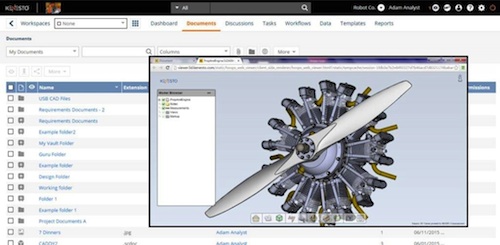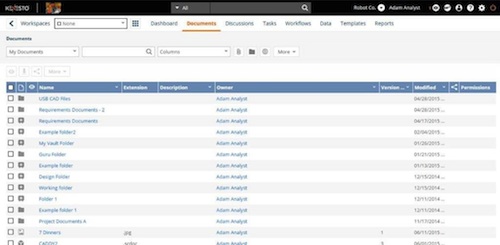Kenesto Drive Positioned as Dropbox for Engineers

Kenesto Drive’s viewing capabilities allows engineers to view 2D and 3D designs in a browser. Image Courtesy of Kenesto
July 29, 2015
Kenesto has taken many twists and turns in its journey, making a big initial splash as a PLM alternative, turning slightly towards business processes and workflow and more recently, settling into a steady course as an engineering document and file management solution.
In keeping with that trajectory, Kenesto has broken out Drive, one of the key features of its system, as a standalone offering. It is positioning the virtual cloud drive as an alternative to general-purpose cloud storage tools and taking specific aim at engineers and designers. Kenesto Drive has browser-based 2D/3D viewing capabilities, synchronization functionality and version and permission controls not supported by popular consumer-oriented cloud storage tools like Dropbox and Box, which are often employed by its small- to-mid-size target audience for engineering-specific applications.
 Kenesto is pitching its Drive capability as an alternative to general-purpose cloud storage tools. Image Courtesy of Kenesto
Kenesto is pitching its Drive capability as an alternative to general-purpose cloud storage tools. Image Courtesy of KenestoSmaller shops, most of which don’t have PDM or PLM in place, often rely on shared drives to store engineering documents and CAD files. Some have augmented this base functionality with cloud storage services like Dropbox, but Kenesto contends those offerings are lacking the critical 2D/3D viewing capabilities and set of shared permissions that are so critical when storing and managing design IP.
“One of the struggles that people have is that they’re really just looking for simple document management capabilities,” says Steve Bodnar, Kenesto’s senior vice president, strategy and products. “We’ve created Kenesto Drive to address the engineering customer who uses a shared drive in a corner somewhere.”
Kenesto Drive is also a way to get potential customers acquainted with the Kenesto platform. The free version of Kenesto Drive affords users the basic file sharing and storage capabilities, including automatic synchronization of files between the desktop, web and mobile platforms via the web browser app along with the ability to view and share 2D and 3D engineering documents in a browser, and functionality to lock down files for editing.
 Kenesto Drive’s viewing capabilities allows engineers to view 2D and 3D designs in a browser. Image Courtesy of Kenesto
Kenesto Drive’s viewing capabilities allows engineers to view 2D and 3D designs in a browser. Image Courtesy of KenestoKenesto Pro, available as a paid annual subscription for $25 a user per month, includes the standard Drive capabilities along with Kenesto’s other engineering-oriented capabilities such as workflow management, collaboration, document check in and check out, workspaces for different projects, forms, reports, discussions, and other various lightweight PDM functionality.
While Kenesto Drive is likely to appeal to users without PDM systems, it also has applicability for companies using PDM to share engineering documents and files internally. “Even those companies that have PDM — it’s still internal to their company,” Bodnar explained. “It doesn’t help companies collaborate with suppliers or customers or virtual contractors.”
That’s where tools like Dropbox come in, but with them, Bodnar says companies are creating a secondary environment with all the security risks around design IP. “With Kenesto Drive, we’re giving them one tool to get both of those in one place — simple document management and collaboration just like they would with a shared drive, but with better permissions and security,” he explained. “And it’s not overwhelming like a PDM system.”
For more information on the Kenesto solution and the free Kenesto Drive, check out this video.
Subscribe to our FREE magazine, FREE email newsletters or both!
About the Author
Beth Stackpole is a contributing editor to Digital Engineering. Send e-mail about this article to [email protected].
Follow DE





